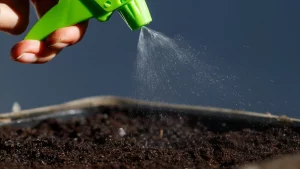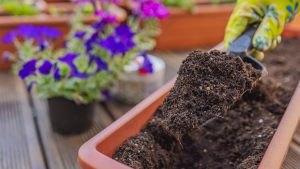Contents
- 1 10 Eco-Friendly Gardening Tips for a Greener Home Garden
- 1.1 1. Choose Native and Pollinator-Friendly Plants
- 1.2 2. Ditch Chemicals and Go Organic
- 1.3 3. Make and Use Compost
- 1.4 4. Save Water with Smarter Systems
- 1.5 5. Go Peat-Free
- 1.6 6. Reuse, Recycle & Upcycle
- 1.7 7. Grow Your Own Food
- 1.8 8. Use Mulch to Protect Soil
- 1.9 9. Choose Energy-Efficient Tools
- 1.10 10. Create a Wildlife Corner
- 1.11 FAQs About Eco-Friendly Gardening
- 1.12 Related Articles
- 1.13 Final Thoughts on Eco-Friendly Gardening
10 Eco-Friendly Gardening Tips for a Greener Home Garden
Want to make your garden thrive without harming the planet? Eco-friendly gardening is all about growing plants sustainably — saving water, reducing waste, and protecting nature while enjoying a lush, vibrant garden.
Whether you’re planting vegetables, flowers, or herbs, these 10 proven eco-friendly gardening tips will help you create a beautiful, low-impact garden that benefits both your plants and the planet.
1. Choose Native and Pollinator-Friendly Plants
Native plants are adapted to your local climate and soil — meaning they need less water, fertilizer, and maintenance. Plus, they attract bees, butterflies, and other beneficial pollinators.
Why It Helps:
Reduces pesticide use
Saves water
Supports local biodiversity
Try adding lavender, echinacea, or marigolds — all great pollinator magnets.

2. Ditch Chemicals and Go Organic
Synthetic fertilizers and pesticides can harm soil life and contaminate water. Switch to organic plant feeds and natural pest control methods instead.
Eco Alternatives:
Compost or worm castings for nutrients
Neem oil or garlic spray for pests
Mulch to suppress weeds naturally
Neem Oil Spray on Amazon is an excellent natural option for controlling pests without harsh chemicals.

3. Make and Use Compost
Composting turns kitchen scraps and garden waste into nutrient-rich soil food. It reduces landfill waste and boosts soil fertility naturally.
Compost-Friendly Items:
Fruit and veggie peels
Coffee grounds
Grass clippings and leaves
4. Save Water with Smarter Systems
Water is one of the most precious resources in your garden. Using the right techniques ensures nothing goes to waste.
How to Save Water:
Install drip irrigation systems for slow, direct watering.
Collect rainwater in barrels.
Water early in the morning to minimize evaporation.
5. Go Peat-Free
Peat extraction damages fragile ecosystems and releases stored carbon. Switch to peat-free composts made from coco coir or bark-based mixes.
Pro Tip: Mix in homemade compost to add nutrients and improve structure.
Westland Peat-Free Compost on Amazon is a great option that’s sustainable and nutrient-rich.

6. Reuse, Recycle & Upcycle
You don’t always need to buy new gardening supplies. Look around — there’s plenty you can reuse!
Creative Ideas:
Turn yogurt cups into seed starters.
Use glass jars as mini greenhouses.
Repurpose pallets into vertical planters.
7. Grow Your Own Food
Homegrown vegetables reduce packaging waste and lower your carbon footprint. Even a small garden bed or balcony planter can produce fresh, chemical-free food.
Easy Crops to Start:
Lettuce
Cherry tomatoes
Spinach
Strawberries
8. Use Mulch to Protect Soil
Mulching helps retain moisture, prevent weeds, and improve soil health — a must for sustainable gardening.
Eco Mulch Options:
Straw
Wood chips
Grass clippings
9. Choose Energy-Efficient Tools
Battery-powered and manual tools are quieter, cleaner, and more sustainable than gas-powered ones.
Eco Tool Ideas:
Solar-powered garden lights
Cordless electric trimmers
Hand tools with bamboo handles
10. Create a Wildlife Corner
Encourage biodiversity by dedicating a small space for nature.
Add:
A bird bath or bee hotel
Native wildflowers
Leaf piles for insects
Small habitats help balance your garden’s ecosystem and invite pollinators that improve your plant health.
FAQs About Eco-Friendly Gardening
1. Is eco-friendly gardening expensive?
Not at all. In fact, it often saves money by reducing fertilizer, water, and waste costs.
2. What’s the easiest eco-friendly change for beginners?
Start composting and using rainwater — both easy and immediately impactful.
3. Can I make my existing garden more sustainable?
Yes! Swap out chemical fertilizers for organic ones and gradually switch to peat-free soil and native plants.
Related Articles
Final Thoughts on Eco-Friendly Gardening
A greener garden starts with small, intentional choices. By composting, conserving water, and choosing natural materials, you’ll grow a thriving, beautiful garden that helps the environment — one seed at a time.

